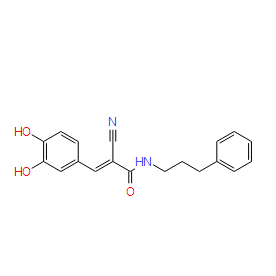| Cas No.: | 133550-34-2 |
| Chemical Name: | (E)-2-Cyano-3-(3,4-dihydroxyphenyl)-N-(3-phenylpropyl)-2-propenamide |
| Synonyms: | Tyrphostin AG 555,Tyrphostin AG-555,Tyrphostin AG555 |
| SMILES: | C1=CC=C(C=C1)CCCNC(=O)/C(=C/C2=CC(=C(C=C2)O)O)/C#N |
| Formula: | C19H18N2O3 |
| M.Wt: | 322.36 |
| Sotrage: | 2 years -20°C Powder, 2 weeks 4°C in DMSO, 6 months -80°C in DMSO |
| Description: | AG 555 is an EGFR tyrosine kinase inhibitor. |
| In Vitro: | The tyrosine kinase inhibitor (Tyrphostin) AG 555 selectively interferes with viral transcription in bovine papillomavirus type 1 (BPV-1)-transformed fibroblasts and induces suppression of cyclin-dependent kinase activity and cell cycle arrest. AG 555 treatment also leads to an activation of the mitogen-activated protein kinase pathway by enhancing phosphorylation of JNK and p38. Tyrphostin AG 555 disturbs the balance of negative and positive regulatory factors necessary to maintain the homeostasis of a virus-transformed phenotype. Tyrphostin AG 555 can selectively suppress BPV-1 transcription through MAP kinase pathway activation and binding of phosphorylated Jun/ATF-2 at a novel intragenic regulatory sequence. AG 555 affects the transcription of the major regulatory viral protein E2 by shifting the ratio between E2 transactivator in favor to the repressor function. Cell incubation in the presence of 30 μM AG 555 results in a selective down-regulation of the most abundant viral transcripts already 4 h after drug application[2]. Tyrphostins AG555, which blocks Cdk2 activation, induces growth arrest of immortalized cells at G1-S and early S and is very effective in arresting the growth of EGFR overexpressor cells. AG55 inhibits the growth of HPV16-immortalized cells. AG555 is already effective at 10 μM (IC50=6.4, respectively), and the cells remain arrested after withdrawal of the compound on day 5 as monitored on days 8 and 12[3]. |

 To enhance service speed and avoid tariff delays, we've opened a US warehouse. All US orders ship directly from our US facility.
To enhance service speed and avoid tariff delays, we've opened a US warehouse. All US orders ship directly from our US facility.




















